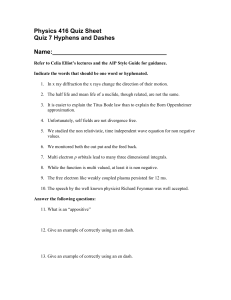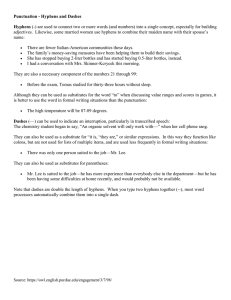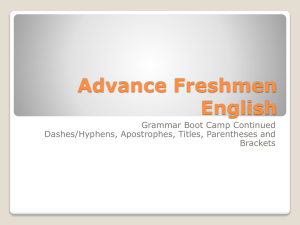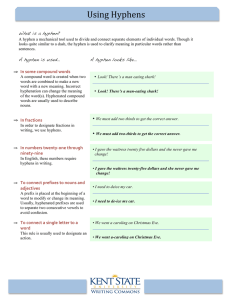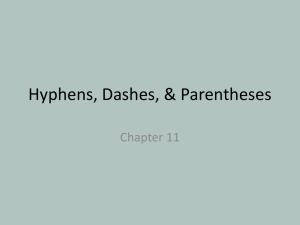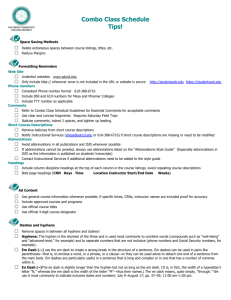Hyphens, Dashes, and Minus Signs
advertisement
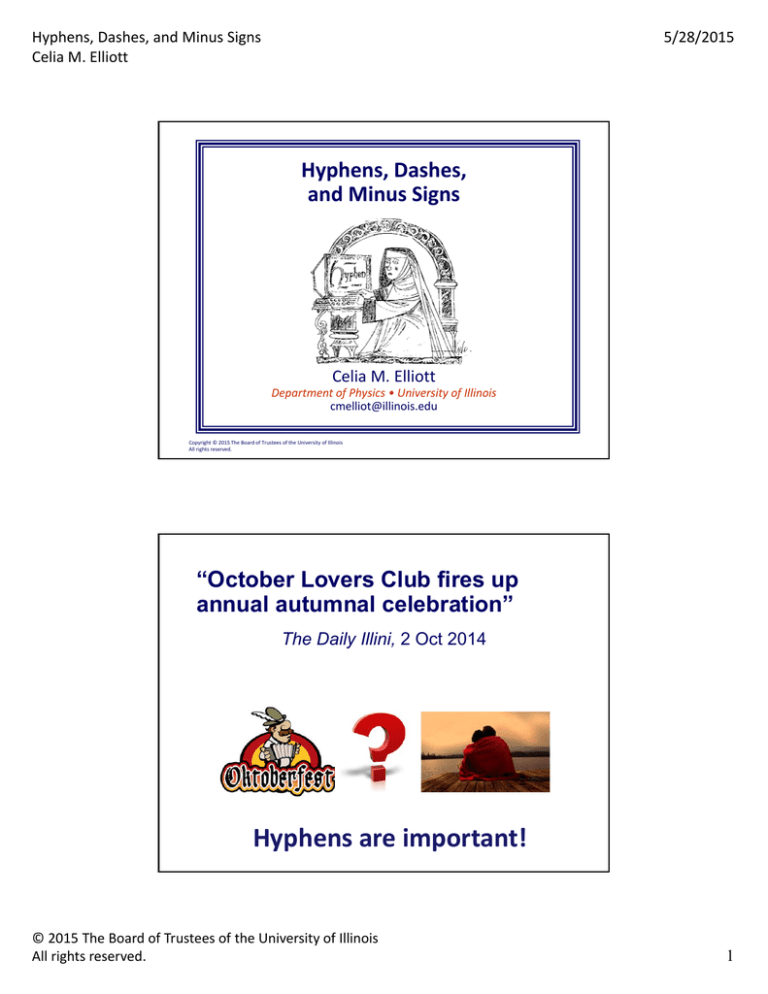
Hyphens, Dashes, and Minus Signs
Celia M. Elliott
5/28/2015
Hyphens, Dashes, and Minus Signs
Celia M. Elliott
Department of Physics • University of Illinois cmelliot@illinois.edu Copyright © 2015 The Board of Trustees of the University of Illinois
All rights reserved.
“October Lovers Club fires up
annual autumnal celebration”
The Daily Illini, 2 Oct 2014
Hyphens are important!
© 2015 The Board of Trustees of the University of Illinois
All rights reserved.
1
Hyphens, Dashes, and Minus Signs
Celia M. Elliott
5/28/2015
Four varieties of horizontal lines are used as punctuation in technical writing
em dash —
Used to punctuate sentences
en dash –
Used to indicate a range of numbers
minus sign –
Used to denote a mathematical quantity or operation
hyphen ‐
Used to break or join words
Em dashes are used for punctuation
Around appositives, when the use of commas would cause confusion
“However, during certain events—for example, when a
mineral crystallizes from a melt and cools—the daughter
products of radioactive decay can no longer equilibrate,
preserving the state of the system.” Science 297, 1658 (2002).
In place of commas for emphasis
“The EFT effective potential has a huge number of
metastable dS minima—more than e100 of them.”
Physics Today 57 (4), 50 (2004).
© 2015 The Board of Trustees of the University of Illinois
All rights reserved.
2
Hyphens, Dashes, and Minus Signs
Celia M. Elliott
5/28/2015
Em dashes can also be used instead of colons and parentheses
Instead of a colon to introduce a series
“These are followed by discussions of fundamental
photonic devices and techniques—beam splitters,
homodyne detection, interferometers, and photon-count
statistics.” Physics Today 55, 54 (2002).
Instead of parentheses to emphasize
parenthetical information
“These and similar measures—the ERC made some
20 recommendations—are intended to keep CERN
tightly focused on successfully completing the LHC.”
Physics Today 55, 27 (2002).
Replace semicolons with dashes
to strengthen the connection
between two independent clauses
with a semicolon:
“The density of states is low; MgB2 has no
d electrons.” Physics Today 56, 38 (2003).
with an em dash:
“The density of states is low—MgB2 has no
d electrons.”
© 2015 The Board of Trustees of the University of Illinois
All rights reserved.
3
Hyphens, Dashes, and Minus Signs
Celia M. Elliott
5/28/2015
Replace a comma with an em dash to focus the reader’s attention
with a comma:
“Combining the fabrication capabilities of the
STM with various modes of spectroscopic
measurements will provide a unique means of
exploring quantum coherence and entanglement
issues, one spin at a time.”
with an em dash:
“Combining the fabrication capabilities of the
STM with various modes of spectroscopic
measurements will provide a unique means of
exploring quantum coherence and entanglement
issues—one spin at a time.”
Horrible example:
Because contributions to the muon anomaly
from known processes, such as QED, the weak
interaction, and hadronic vacuum polarization
(HVP), including higher-order terms, are
believed to be understood at the sub-ppm level,
any significant difference between experiment
and theory suggests a yet unknown, and thus not
included, physical process.
49 words! 8 commas!!
© 2015 The Board of Trustees of the University of Illinois
All rights reserved.
4
Hyphens, Dashes, and Minus Signs
Celia M. Elliott
5/28/2015
Super em dash to the rescue—
Because contributions to the muon anomaly
from known processes—QED, the weak
interaction, and hadronic vacuum polarization
(HVP), including higher-order terms—are
believed to be understood at the sub-ppm level,
any significant difference between experiment
and theory suggests a yet unknown (and thus not
included) physical process.
Creating an em dash (—)
Word®: Insert “Symbol”—available in both “normal text” and “symbol” fonts
Shortcut: Crtl + Alt + numeric keypad ‐
Set “Autocorrect” to automatically substitute an em dash when you type two hyphens
HTML: —
TeX: ‐‐‐ (three hyphens)
If you really want three hyphens, type {‐}{‐}{‐}
© 2015 The Board of Trustees of the University of Illinois
All rights reserved.
5
Hyphens, Dashes, and Minus Signs
Celia M. Elliott
5/28/2015
En dashes are almost always used to indicate a range of numbers
Examples: References 6–11, 143–167 pages, 480–530 nm
Caution!! The interpretation of the en dash in a range can be ambiguous— does it mean “to” or “through”?
Dates extending over parts of two successive calendar years are indicated by a solidus (/) instead of an en dash Winter 2005/06,
Academic Year 2005/06
N.B. writing 2005–2006 would indicate two entire years
An en dash may be used to join some compound modifiers
In a compound adjective formed from proper names
Fermi–Dirac–Sommerfeld law
Bose–Einstein condensate
In a compound adjective, when one or both elements consist of multiple words or a hyphenated word
superconductor–normal metal interface
high-density–low-cholesterol lipoprotein
12
© 2015 The Board of Trustees of the University of Illinois
All rights reserved.
6
Hyphens, Dashes, and Minus Signs
Celia M. Elliott
5/28/2015
Creating an en dash (–)
Word®: Insert “Symbol”—available in both “normal text” and “symbol” fonts
Keyboard shortcut: Crtl + numeric keypad ‐
HTML: –
TeX: ‐‐ (two hyphens)
Do not use spaces with dashes
Em dashes and en dashes are neither preceded nor followed by spaces
“If a photon in state | passes through a polarizing
beamsplitter—a device that reflects (transmits)
horizontally (vertically) polarized photons—it will
be found in the reflected (transmitted) beam with
probability ||2(||2).” Nature 390, 576 (1997).
“P (2 < 2min ) is 95.2%, 96.5%, 94.8% for the
multipole ranges 401–1000, 401–750, 726–1025,
respectively.” astro-ph/0105296v1 (2001).
1 – 6
© 2015 The Board of Trustees of the University of Illinois
All rights reserved.
7
Hyphens, Dashes, and Minus Signs
Celia M. Elliott
5/28/2015
Do not use hyphens for minus signs in numerical expressions
In negative numbers
–25oC
1.710–6 atoms
In mathematical operations
a–b=c
Use a thin space before and after a minus sign if it represents a mathematical operation
Creating a minus sign (–)
Word®: Insert “Symbol”—available in both “normal text” and “symbol” fonts
Keyboard shortcut: Crtl + numeric keypad ‐
HTML: &#150;
TeX: $‐$ (math mode)
© 2015 The Board of Trustees of the University of Illinois
All rights reserved.
8
Hyphens, Dashes, and Minus Signs
Celia M. Elliott
5/28/2015
Hyphens have only two uses in technical writing
To break words at the end of a line
“Nanowires have attracted extensive interest
in recent years because of their unusual quantum properties.” Science 294, 348 (2001).
To join words in compound nouns or
compound adjectives
co-worker, self-energy
“Now Drew Geller and Swift have built off-the-shelf
speaker-pipe modules that, when hooked together,
use a traveling acoustic wave to achieve arbitrary
degrees of purity in the separation process.”
Physics Today 57(4), 9 (2004).
Use a hyphen to create compound modifiers
Nouns, adjectives, adverbs, and numbers are joined with hyphens to make an adjective modifying a noun
noun‐noun adjective‐noun
adverb‐adj‐noun
number‐noun
galaxy-galaxy collisions
high-energy physics
very-large-scale integration (VLSI)
20-nm layer
Adverbs ending in “ly” are not attached by hyphens in compound modifiers
highly charged particles
longitudinally polarized hydrogen target
© 2015 The Board of Trustees of the University of Illinois
All rights reserved.
9
Hyphens, Dashes, and Minus Signs
Celia M. Elliott
5/28/2015
Stick hyphens in compound modifiers carefully
Some compound modifiers are never hyphenated*
condensed matter physics
Monte Carlo calculations
*but should be
finite element analysis
heterojunction bipolar transistor
molar absorption coefficient
Judgment is required
self-assembled carbon nanotubes or
self-assembled-carbon nanotubes
polarized hydrogen target or
polarized-hydrogen target
Some more from the AIP—
“The tendency in scientific spelling is to avoid the
hyphen when it does not serve a useful purpose.”
“Useful purposes”:
If closing up would produce double letters, e.g., non-negative, electro-optical;
but unnecessary, coordinate, deexcitation
If a prefix or suffix is added to a proper noun, symbol, or numeral, e.g.,
non-Fermi, Bose-like, di-MeB, pseudo-P,
13-fold
© 2015 The Board of Trustees of the University of Illinois
All rights reserved.
10
Hyphens, Dashes, and Minus Signs
Celia M. Elliott
5/28/2015
“self‐”, “free‐”, and “half‐” words are usually hyphenated
“Self” words are almost always hyphenated
self-consistent, self-inductance
but selfsame
“Half” words are usually hyphenated
half-life, half-width, half-baked
but halftone and halfway and half step
“Free” words are often hyphenated
divergence-free,
but free fall and freestanding
Tip: Invest in a good dictionary and use it
—nobody can remember all the exceptions.
Hyphenating “well” words is tricky
“Well” words are hyphenated when they are used as adjectives preceding a noun
the well-known Coriolis effect
the well-studied sign problem in quantum Monte Carlo
“Well” words are not hyphenated when they modify a “to be” verb (now the “well” is an adverb modifying the verb)
The BCS theory has been well accepted by the community.
Right or wrong?
Celia Elliott is a well regarded technical editor.
Brian DeMarco is well-known in the AMO community.
© 2015 The Board of Trustees of the University of Illinois
All rights reserved.
11
Hyphens, Dashes, and Minus Signs
Celia M. Elliott
5/28/2015
Words with prefixes and suffixes are usually not hyphenated
Units of measure that incorporate “powers” prefixes when the units are written as words, e.g., femtosecond, milligram, gigavolt, terahertz
but kilohm and kilo-oersted
Other examples: birefringence, diagonalizable,
multivalent, photoinduced, nonionized, preionized,
(but un-ionized)
If the prefix or suffix is added to more than one root word, hyphenate them all,
e.g., non-time-dependent, free-electron-like
Don’t hyphenate your “anties”
Antiparticles are not hyphenated
antiproton, antineutron
“antimatter” is not hyphenated
“antilog” and “antilogrithm” and
“antilogrithmic” are not hyphenated
“anharmonic” and “anisotropic”
are not hyphenated (use “an” instead of “anti” before words beginning with “h” or “i”)
© 2015 The Board of Trustees of the University of Illinois
All rights reserved.
12
Hyphens, Dashes, and Minus Signs
Celia M. Elliott
5/28/2015
“band” words are not hyphenated; they’re wri en either closed or open†
band edge
band gap
bandhead
bandlimited
bandpass
band shape
band shift
band spectrum
band structure
bandwidth
(but d-band width)
AIP Style Manual, 4th ed., Appendix B
†apparently based solely on the irrational whim of AIP copy editors; just memorize ’em—cme
“wave” words are not hyphenated; they’re wri en either closed or open†
wave field
wave form
wave front
wave function
waveguide
waveheight
wavelength
wave number
wave packet
wave vector
AIP Style Manual, 4th ed., Appendix B
†apparently based solely on the irrational whim of AIP copy editors; just memorize ’em—cme
© 2015 The Board of Trustees of the University of Illinois
All rights reserved.
13
Hyphens, Dashes, and Minus Signs
Celia M. Elliott
5/28/2015
Finally, “cross” words appear to be completely random
cross-check
cross field
crosshatched
crossover
cross term
cross section
cross-section
Fig. 1. Cross section limit as a function of lifetime, for a
b' mass of 150 GeV, compared with the theoretical cross
section.
Absorber materials are used for radar cross-section
reduction.
Compounds evolve in English—
Evolution is open hyphenated closed
data base data-base database
broad band broad-band broadband
If you’re not sure where your word is in its evolutionary journey, consult a scientific dictionary or the AIP Style Guide (Appx. B)
If you’re sure, look it up anyway—
you will learn humility
© 2015 The Board of Trustees of the University of Illinois
All rights reserved.
14
Hyphens, Dashes, and Minus Signs
Celia M. Elliott
5/28/2015
Learn the notation that copy
editors use to correct text
Insert em dash
mark a caret (^) in the text where the dash is to be inserted
1
in the margin, write M
Insert en dash
mark a caret (^) in the text where the dash is to be inserted
1
in the margin, write N
Insert hyphen
mark a caret (^) in the text where the hyphen is to be inserted and draw a hyphen above the line of text
To recap:
Use em dashes as emphatic punctuation
Use en (n) dashes for number ranges
Take the time to insert a minus sign—don’t be sloppy and make do with a hyphen
Hyphens are used only to break words at the end of a line or to make adjectives
Celia Mathews Elliott
cmelliot@illinois.edu
© 2015 The Board of Trustees of the University of Illinois
All rights reserved.
15
